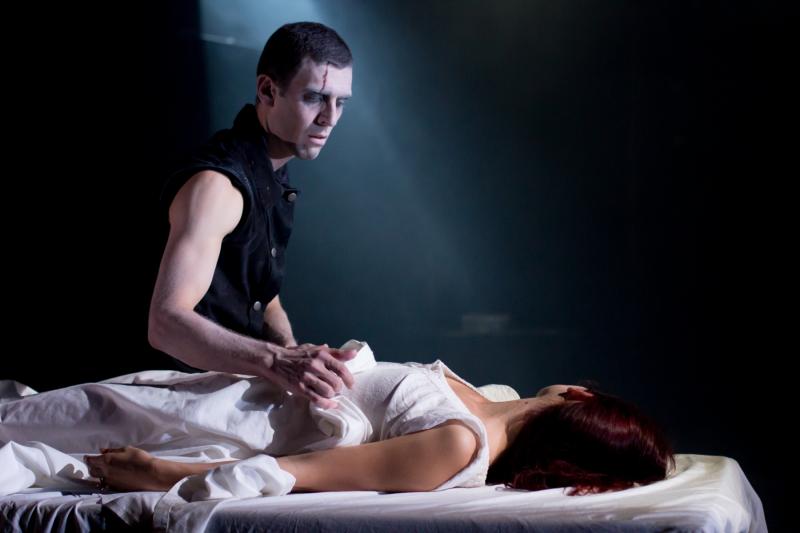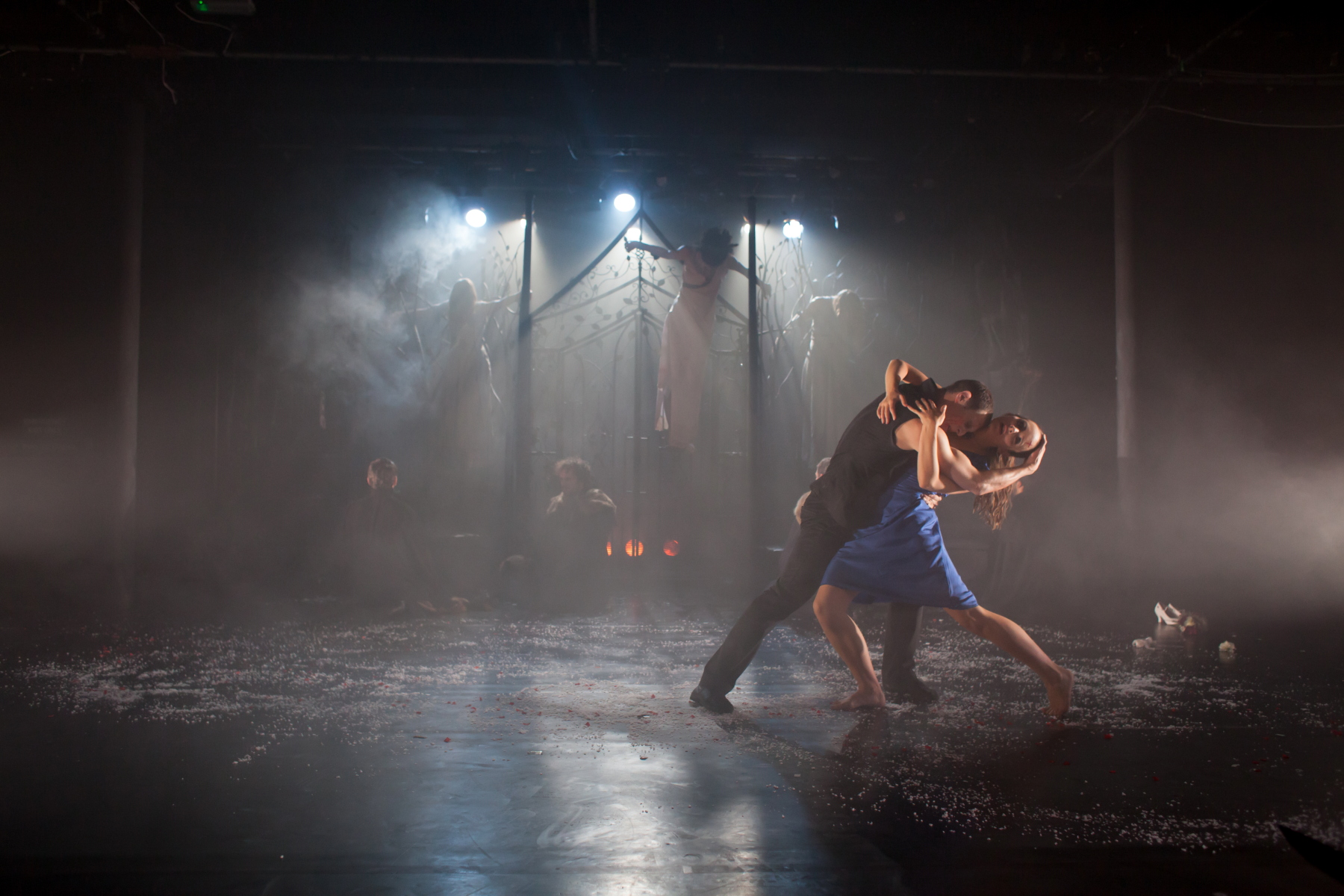Dracula, Mark Bruce Company, Tobacco Factory, Bristol | reviews, news & interviews
Dracula, Mark Bruce Company, Tobacco Factory, Bristol
Dracula, Mark Bruce Company, Tobacco Factory, Bristol
Vampire classic with a dance theatre twist

The rich cocktail of sex, bestiality and possession that lies at the heart of the vampire myth is a perennial crowd-pleaser, a surefire frightener set in an all-too-familiar discomfort zone. Mark Bruce’s rich and reference-laden take on Bram Stoker’s 1897 classic presents a Transylvanian count who is both Everyman and Other.
Dance theatre is less abstract than most contemporary dance: there is plenty of emotion and narrative, even if the strands of story are held together by allusive poetic association rather than straight-arrrow logic. This version of Stoker’s story – the literary original something of a disjointed collage – works less well when it is bound by conventions of step-by-step storytelling. There are some clunky transitions in the first half of the show and Jonathan Harker’s ride up to the castle of horrors, in a static coach led by horse-headed dancers whose movements feel contrived, is not as convincing as some captivating moments of choreography, when body language, free of literal or literary burdens, suggests so much more.
When he dances, it's as if he were haunted through every cell of his body with carnal desire
Jonathan Goddard, who plays the count, steals the show. He has a gaunt and chiseled physiognomy that fits the part, and he manages to move and act in a way that subtly evokes an unholy mixture of profound melancholy, vulnerability and ferocity. Whenever he dances, there is a sense of danger tinged with infinite sadness, as if he were haunted through every cell of his body with an excess of carnal desire. And when he stops, the slightest move of his head, shoulder or arm speaks volumes in terms of trapped emotion.
The other dancers are not quite in his league, although Eleanor Duval as Mina Harker and Kristin McGuire as Lucy Westenra are both first class. The dances that evoke the passion of sexual embrace, laced with voracious blood-sucking, are all riveting while only just steering clear of gross excess, but the story is, after all, about the gross rather than the refined. Mark Bruce’s allusions to Victorian music hall humour and bawdiness fit very neatly into his always thought-provoking exploration of the Dracula myth.
 The production is steeped in references – sometimes playfully ironic - to fin-de-siècle sensibilities, for this is a period-piece, filled with the dominant obsessions of the moment when Freud popularized the idea of the unconscious and the primacy of sexual desire: the hysterical writhing of the vampire brides and Lucy Westenra, histrionic women’s poses reminiscent of the Swiss symbolist Ferdinand Holder, who was in turn inspired by the stylised dance-work of Dalcroze. The show is graced with a startling but always well-chosen variety of music, which plays a crucial part in supercharging the dancers’ intense performances: from Schnittke’s dramatic 4th Symphony to moody drones by guitarist Fred Frith. Ligeti’s second String Quartet, all angles and dissonance, enhances the noir-ish expressionism of the piece.
The production is steeped in references – sometimes playfully ironic - to fin-de-siècle sensibilities, for this is a period-piece, filled with the dominant obsessions of the moment when Freud popularized the idea of the unconscious and the primacy of sexual desire: the hysterical writhing of the vampire brides and Lucy Westenra, histrionic women’s poses reminiscent of the Swiss symbolist Ferdinand Holder, who was in turn inspired by the stylised dance-work of Dalcroze. The show is graced with a startling but always well-chosen variety of music, which plays a crucial part in supercharging the dancers’ intense performances: from Schnittke’s dramatic 4th Symphony to moody drones by guitarist Fred Frith. Ligeti’s second String Quartet, all angles and dissonance, enhances the noir-ish expressionism of the piece.
It came to mind, while watching this highly original show, how much the Dracula story is connected to the myth of Dionysus, the Greek god of the life force, reborn like Jesus, and whose Maenad followers devour raw flesh. Connected to madness, possession and theatre, he is also the Lord of the Dance, a cousin of Shiva, and the mix of darkness and celebration at the heart of Mark Bruce’s production, expressed through a wide range of movement vocabulary, goes way beyond the merely grisly depiction of a vampire count from the Balkans.
rating
Explore topics
Share this article
The future of Arts Journalism
You can stop theartsdesk.com closing!
We urgently need financing to survive. Our fundraising drive has thus far raised £49,000 but we need to reach £100,000 or we will be forced to close. Please contribute here: https://gofund.me/c3f6033d
And if you can forward this information to anyone who might assist, we’d be grateful.

Subscribe to theartsdesk.com
Thank you for continuing to read our work on theartsdesk.com. For unlimited access to every article in its entirety, including our archive of more than 15,000 pieces, we're asking for £5 per month or £40 per year. We feel it's a very good deal, and hope you do too.
To take a subscription now simply click here.
And if you're looking for that extra gift for a friend or family member, why not treat them to a theartsdesk.com gift subscription?
more Dance
 'We are bowled over!' Thank you for your messages of love and support
Much-appreciated words of commendation from readers and the cultural community
'We are bowled over!' Thank you for your messages of love and support
Much-appreciated words of commendation from readers and the cultural community
 R:Evolution, English National Ballet, Sadler's Wells review - a vibrant survey of ballet in four acts
ENB set the bar high with this mixed bill, but they meet its challenges thrillingly
R:Evolution, English National Ballet, Sadler's Wells review - a vibrant survey of ballet in four acts
ENB set the bar high with this mixed bill, but they meet its challenges thrillingly
 Like Water for Chocolate, Royal Ballet review - splendid dancing and sets, but there's too much plot
Christopher Wheeldon's version looks great but is too muddling to connect with fully
Like Water for Chocolate, Royal Ballet review - splendid dancing and sets, but there's too much plot
Christopher Wheeldon's version looks great but is too muddling to connect with fully
 iD-Reloaded, Cirque Éloize, Marlowe Theatre, Canterbury review - attitude, energy and invention
A riotous blend of urban dance music, hip hop and contemporary circus
iD-Reloaded, Cirque Éloize, Marlowe Theatre, Canterbury review - attitude, energy and invention
A riotous blend of urban dance music, hip hop and contemporary circus
 How to be a Dancer in 72,000 Easy Lessons, Teaċ Daṁsa review - a riveting account of a life in dance
Michael Keegan-Dolan's unique hybrid of physical theatre and comic monologue
How to be a Dancer in 72,000 Easy Lessons, Teaċ Daṁsa review - a riveting account of a life in dance
Michael Keegan-Dolan's unique hybrid of physical theatre and comic monologue
 A Single Man, Linbury Theatre review - an anatomy of melancholy, with breaks in the clouds
Ed Watson and Jonathan Goddard are extraordinary in Jonathan Watkins' dance theatre adaptation of Isherwood's novel
A Single Man, Linbury Theatre review - an anatomy of melancholy, with breaks in the clouds
Ed Watson and Jonathan Goddard are extraordinary in Jonathan Watkins' dance theatre adaptation of Isherwood's novel
 Peaky Blinders: The Redemption of Thomas Shelby, Rambert, Sadler's Wells review - exciting dancing, if you can see it
Six TV series reduced to 100 minutes' dance time doesn't quite compute
Peaky Blinders: The Redemption of Thomas Shelby, Rambert, Sadler's Wells review - exciting dancing, if you can see it
Six TV series reduced to 100 minutes' dance time doesn't quite compute
 Giselle, National Ballet of Japan review - return of a classic, refreshed and impeccably danced
First visit by Miyako Yoshida's company leaves you wanting more
Giselle, National Ballet of Japan review - return of a classic, refreshed and impeccably danced
First visit by Miyako Yoshida's company leaves you wanting more
 Quadrophenia, Sadler's Wells review - missed opportunity to give new stage life to a Who classic
The brilliant cast need a tighter score and a stronger narrative
Quadrophenia, Sadler's Wells review - missed opportunity to give new stage life to a Who classic
The brilliant cast need a tighter score and a stronger narrative
 The Midnight Bell, Sadler's Wells review - a first reprise for one of Matthew Bourne's most compelling shows to date
The after-hours lives of the sad and lonely are drawn with compassion, originality and skill
The Midnight Bell, Sadler's Wells review - a first reprise for one of Matthew Bourne's most compelling shows to date
The after-hours lives of the sad and lonely are drawn with compassion, originality and skill
 Ballet to Broadway: Wheeldon Works, Royal Ballet review - the impressive range and reach of Christopher Wheeldon's craft
The title says it: as dancemaker, as creative magnet, the man clearly works his socks off
Ballet to Broadway: Wheeldon Works, Royal Ballet review - the impressive range and reach of Christopher Wheeldon's craft
The title says it: as dancemaker, as creative magnet, the man clearly works his socks off
 The Forsythe Programme, English National Ballet review - brains, beauty and bravura
Once again the veteran choreographer and maverick William Forsythe raises ENB's game
The Forsythe Programme, English National Ballet review - brains, beauty and bravura
Once again the veteran choreographer and maverick William Forsythe raises ENB's game

Add comment